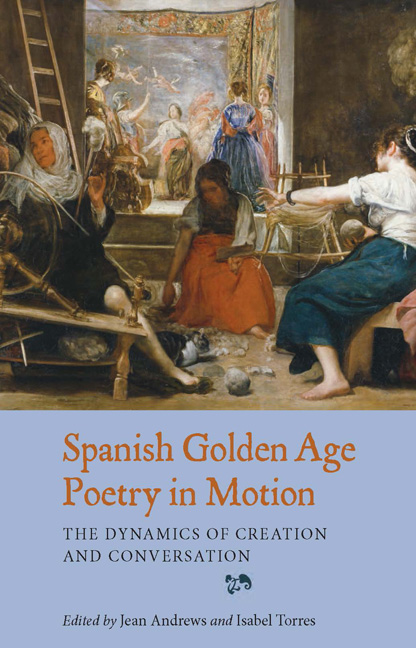Book contents
- Frontmatter
- Contents
- Contributors
- Acknowledgements
- Introduction
- 1 La poesía mutante del Siglo de Oro
- Part 1 Poetry in Creation
- 2 Moving in …Garcilaso de la Vega's ‘Dulces prendas por mi mal halladas’
- 3 The Movement of Thought and Feeling in the ‘Ode to Juan de Grial’
- 4 Metaphors of Movement in Two Poems of Fray Luis de León
- 5 El tiempo medido en versos: Camila Lucinda en las Rimas (1609) de Lope de Vega
- 6 Upwards to Helicon: Lope de Vega, the Laurel de Apolo, and Acts of Judgement
- 7 ‘Dulce es refugio’: El peregrino de Góngora se detiene
- 8 The Staging of Góngora's Three Funereal Sonnets for Margarita de Austria Estiria
- 9 Jealousy in María de Zayas's Intercalated Poetry: Lyric Illness and Narrative Cure
- 10 Hacia otra lectura del petrarquismo en Sor Juana Inés de la Cruz
- Part 2 Poetry in Conversation
- 11 El conde de Salinas y Leonor Pimentel: cuando se juntan el amor y la poesía
- 12 Poesía popular en movimiento: los jeroglíficos ‘muy propios al intento y muy de su profesión’ en las celebraciones de la Valencia barroca
- 13 Responding to Góngora: María Rosal and the Clori Poems
- 14 Traveling in Place: Baroque Lyric Transports in Translation, or Flames that Bridge the Stream
- Works Cited
- Index
7 - ‘Dulce es refugio’: El peregrino de Góngora se detiene
Published online by Cambridge University Press: 05 November 2014
- Frontmatter
- Contents
- Contributors
- Acknowledgements
- Introduction
- 1 La poesía mutante del Siglo de Oro
- Part 1 Poetry in Creation
- 2 Moving in …Garcilaso de la Vega's ‘Dulces prendas por mi mal halladas’
- 3 The Movement of Thought and Feeling in the ‘Ode to Juan de Grial’
- 4 Metaphors of Movement in Two Poems of Fray Luis de León
- 5 El tiempo medido en versos: Camila Lucinda en las Rimas (1609) de Lope de Vega
- 6 Upwards to Helicon: Lope de Vega, the Laurel de Apolo, and Acts of Judgement
- 7 ‘Dulce es refugio’: El peregrino de Góngora se detiene
- 8 The Staging of Góngora's Three Funereal Sonnets for Margarita de Austria Estiria
- 9 Jealousy in María de Zayas's Intercalated Poetry: Lyric Illness and Narrative Cure
- 10 Hacia otra lectura del petrarquismo en Sor Juana Inés de la Cruz
- Part 2 Poetry in Conversation
- 11 El conde de Salinas y Leonor Pimentel: cuando se juntan el amor y la poesía
- 12 Poesía popular en movimiento: los jeroglíficos ‘muy propios al intento y muy de su profesión’ en las celebraciones de la Valencia barroca
- 13 Responding to Góngora: María Rosal and the Clori Poems
- 14 Traveling in Place: Baroque Lyric Transports in Translation, or Flames that Bridge the Stream
- Works Cited
- Index
Summary
La producción de movimiento en la obra poética del Barroco está asociada usualmente a la trayectoria de un viaje que llega a tener connotaciones alegóricas. Uno de los casos más estelares es la obra de Luis de Góngora, quien abordó en múltiples ocasiones y con una variedad de objetivos estéticos el motivo del viaje y la multifacética figura del peregrino. Ligado indefectiblemente al movimiento de sus pasos, el peregrino gongorino es tan errante como el proceso mismo de la creación poética. Peregrinar, no obstante, no es mero sinónimo de viaje, de movimiento, de desplazamiento y de errático caminar. El objetivo ulterior de su camino no es deambular incesantemente ya que el movimiento está asociado a experiencias negativas como la desorientación, pérdida, confusión y soledad, como notamos desde el comienzo de las Soledades: ‘Pasos de un peregrino son errante/ cuantos me dictó versos dulce Musa,/ en soledad confusa/ perdidos unos, otros inspirados.’ La peregrinatio en la obra de Góngora no es una teleología en sí, sino un medio para alcanzar una forma de quietud en paradas intermedias que afincan, protegen y cobijan al yo y a su poesía. Es el caso del primer albergue en las Soledades que recibe repetidas veces el apóstrofe de ‘bienaventurado albergue, a cualquier hora’. Dicho albergue es central para el desarrollo de la aventura épico-pastoral del protagonista y ocasiona una extensa y profunda misiva anti-cortesana (vv. 94-135) que, en contraste, alaba la hospitalidad y domesticidad de los cabreros.
- Type
- Chapter
- Information
- Spanish Golden Age Poetry in MotionThe Dynamics of Creation and Conversation, pp. 117 - 130Publisher: Boydell & BrewerPrint publication year: 2014



